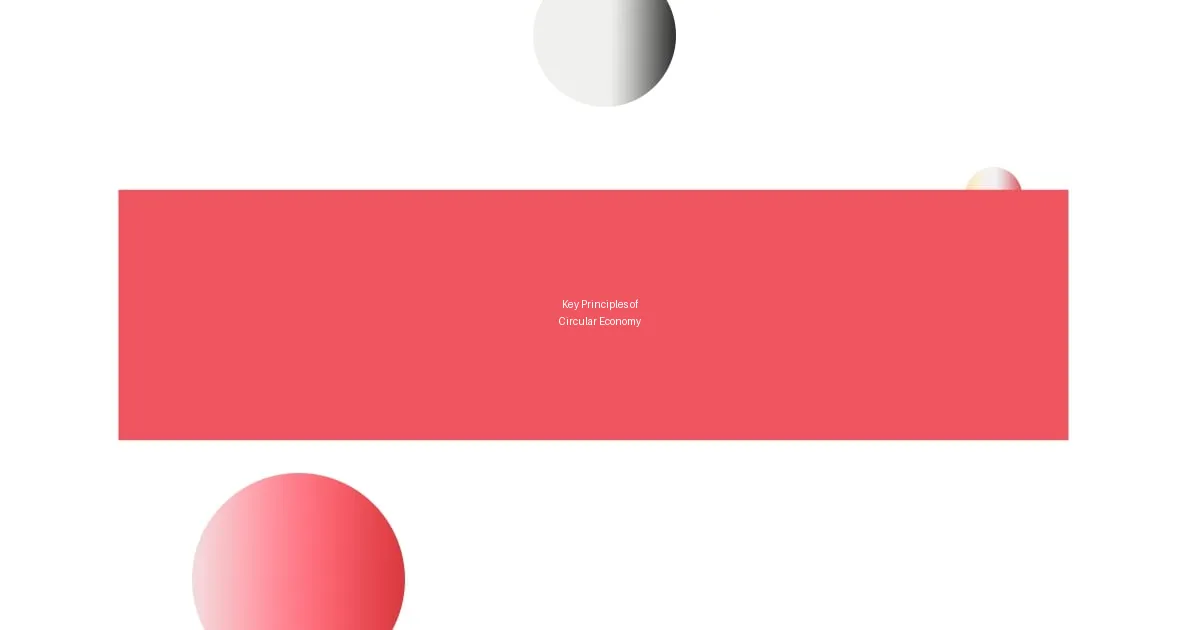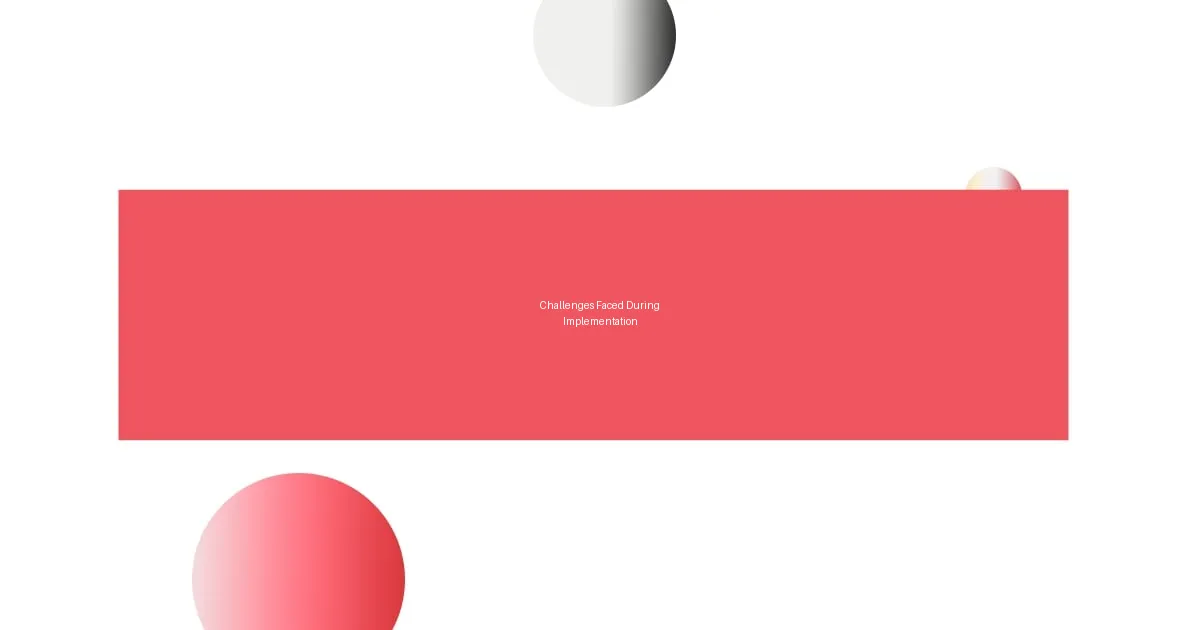Key takeaways:
- The circular economy transforms the linear consumption model into a sustainable practice by minimizing waste and promoting resource reuse.
- Key principles include designing for longevity, resource recovery, and fostering collaboration among stakeholders.
- Personal experiences, like joining a community garden and attending workshops, can significantly enhance awareness and commitment to sustainability.
- Education and storytelling are crucial for inspiring change and engaging others in circular economy practices.

Understanding Circular Economy Basics
Circular economy is an innovative approach that transforms our traditional linear consumption model into a more sustainable practice. Instead of following the old “take, make, dispose” pattern, I’ve come to appreciate how a circular economy aims to create closed-loop systems where waste is minimized, and resources are reused. Have you ever thought about how many items we toss out despite their potential for second life?
Reflecting on my own experience, I remember a time when I decided to repurpose old glass jars instead of throwing them away. Initially, it felt like just a small act, but the joy of transforming something I would’ve discarded into functional storage made me realize the power of rethinking waste. Every time I use those jars, I’m reminded that even simple actions can contribute to a larger systemic change.
Understanding circular economy basics also involves recognizing the interconnectedness of products and services in our lives. This perspective invites us to consider the entire lifecycle of an item. How often do we buy things without considering their end-of-life impact? It’s a question that challenges me to be more mindful with my purchases and encourages discussions about sustainability in my circle, creating ripples of awareness that can inspire others.

Key Principles of Circular Economy
Circular economy is built on a few key principles that encourage sustainability at every stage of a product’s life. One principle is designing for longevity. My own experience with furniture shopping illustrated this perfectly when I chose a timeless piece that I knew I would cherish for years to come. It felt rewarding to invest in something that wouldn’t end up in a landfill after a few seasons.
Another significant principle is resource recovery, which focuses on recovering materials from products that have reached the end of their life. I remember visiting a local recycling center and witnessing how they sorted items for reuse. Seeing the potential in what many deem as waste made me rethink how I dispose of my belongings. It’s empowering to know that with the right systems in place, we can extract value from what we once considered trash.
Lastly, fostering collaboration is crucial in a circular economy. This means businesses, consumers, and even governments working together toward a common goal. A striking moment for me was attending a community workshop where local makers shared techniques for upcycling materials. The vibe was electric as ideas flowed, showcasing how collaboration can spark creativity and innovation. This interconnectedness reminded me that we all play a role in shaping a sustainable future.
| Principle | Description |
|---|---|
| Designing for Longevity | Creating products that are durable and timeless, reducing the need for frequent replacements. |
| Resource Recovery | Retrieving materials from discarded products for reuse, minimizing waste. |
| Fostering Collaboration | Encouraging partnerships among all stakeholders for shared innovation and sustainable practices. |

My Journey in Adopting Practices
In my journey toward adopting circular economy practices, I found that small, mindful changes could have significant impacts. One memorable moment was when I decided to join a community garden. Getting my hands dirty while nurturing plants not only provided fresh produce but also fostered a deeper appreciation for the resources that nature offers. This experience made me feel more connected to my environment and shifted my mindset toward stewardship rather than consumption. I realized that engaging in these practices can ignite a sense of purpose in both myself and others around me.
- Participating in community clean-up events creates a sense of unity and shared responsibility for local spaces.
- I found joy in sharing excess harvests from my garden with neighbors, reinforcing the idea of redistributing resources.
- Discovering the art of sewing and mending clothes instead of discarding them has empowered me to master new skills while also reducing waste.
- Collaborating with friends to host swap parties for clothes and household items transformed my perspective on ownership and consumption.
- Each step I took in this circular journey felt like adding a brushstroke to a larger painting of sustainability, revealing a vibrant picture of possibility.

Challenges Faced During Implementation
Implementing a circular economy approach often presents unexpected challenges that can feel daunting at times. For instance, when I first tried to engage local businesses in sustainability initiatives, I faced resistance. Many had ingrained habits and were hesitant to step out of their comfort zones. It made me wonder: how do you inspire change in those who don’t see the value yet?
Another hurdle I encountered was the complexity of establishing effective waste management systems. I remember a community meeting where we debated the logistics of recycling versus upcycling. It was fascinating to see the different perspectives, but it also highlighted a significant gap in knowledge and resources. How can we bridge these gaps when everyone’s on a different page?
Then there’s the challenge of measuring success. While I embraced the circular principles, tracking my progress felt overwhelming at times. I recall feeling a mix of frustration and hope when I tried to quantify the impact of my gardening efforts. It led me to realize that success doesn’t always need metrics; the small, meaningful changes we experience in our daily lives can be just as impactful. So, how do you define success in a circular economy? For me, it’s about engaging others and nurturing a sense of community towards sustainability, rather than just counting numbers.

Strategies for Effective Transition
Transitioning effectively to a circular economy requires a thoughtful approach. One strategy I found particularly useful was creating a roadmap with clear, achievable goals. Early on, I set small milestones, like reducing my personal waste by a specific percentage or devoting an hour each week to local sustainability projects. These objectives not only provided direction but also helped me stay motivated when the journey felt overwhelming.
Engaging with others is another critical component of this transition. I remember organizing a neighborhood meeting to discuss our collective waste practices. The energy in the room was palpable; everyone contributed ideas and shared their personal stories about sustainability. It struck me how much we could learn from each other. I realized that collaborative efforts can amplify individual actions, making the transition smoother and more enjoyable.
Investing in education—both for myself and my community—proved vital as well. I started attending workshops on circular economy principles and later shared what I learned with friends. The discussions that followed sometimes got intense, but that was where the real magic happened. How often do we hesitate to ask questions? I learned that curiosity is a powerful tool, and fostering a culture of inquiry can propel the transition forward.

Future of Circular Economy Practices
As I look to the future of circular economy practices, it’s inspiring to see more organizations embracing this model. In my experience, once people become aware of their impact, they often feel a sense of responsibility to change. I recall a workshop where one attendee shared how they transformed their business model to minimize waste. Listening to their journey reminded me how powerful storytelling can be; it ignites passion and encourages others to take action. What if more companies shared their successes? Would it create a ripple effect of positive change?
The integration of technology into circular practices also fascinates me. Imagine using apps that connect businesses with surplus materials to those in need—a win-win scenario! I once participated in a local initiative where companies shared waste materials for community art projects. The creativity that blossomed from this collaboration not only recycled resources but also fostered a sense of unity. It got me thinking: how can we leverage technology further to bridge gaps and enhance collaborative opportunities?
Ultimately, the future of circular economy practices hinges on education and advocacy. I vividly remember a time when I joined a panel to discuss sustainable practices at my local school. Witnessing the students’ enthusiasm and fresh ideas left me feeling optimistic about the next generation’s willingness to embrace circularity. If we can cultivate curiosity and critical thinking in our youth, could they lead the charge for a more sustainable world? I firmly believe we’re building a foundation for long-lasting change.















